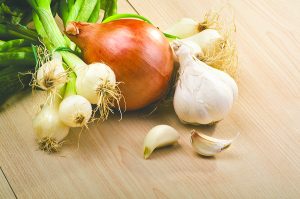Wild onions are heralds of spring
By Angela Shelf Medearis — March 19, 2020Wild onions were among the first foods that mankind gathered and ate, and are one of the first signs of spring. Onions are in the allium family, along with garlic and shallots. There’s nothing like the intense flavor (or the smell) of an onion! Spring onions are my favorites, both as an ingredient and as a vibrant, flavorful garnish. They’re also called green onions, young onions, pencil onions and scallions.
Scallions aren’t as fully ripened as a green onion and should not have a bulb. Spring onions are the milder, first stage of a mature onion. If left in the ground to grow, they’ll form into an onion bulb.
Larger, older spring onions may have limp or faded stalks and a stronger flavor than the smaller ones. Spring onions should be small and thin, with a firm base at the root tip and crisp, bright green leaves. Select spring onions that are not fully developed, with a white bulb end and long green stalks. The flavor of the leaves is milder than the root end. Spring onions will keep for five to seven days when wrapped in plastic and stored in the refrigerator.
Spring onions are a great source of vitamins A and C, iron, calcium and fiber. They also contain a substance that prevents the formation of blood clots. Eating onions helps to lower blood pressure and cholesterol levels.
To prepare spring onions, cut off the roots and peel away the outer layer to remove any lingering soil. Next, rinse the leaves, spreading them gently with your fingers to get at the dirt in the crevices. Both parts are edible. Although the white bulb is most often listed as part of recipes, the green leaves also should be incorporated in recipes and can be used as a garnish too.
Use the green leaves to add a wonderful burst of color, to tie up appetizers into a package or to use as a frilly, edible garnish. To curl the ends, cut off the roots and all but about 3 inches of the green tops. Slice the tops lengthwise down from the green end into the white section. Put the leaves in cold water and chill for several hours to curl them.
While spring onions are best served raw, they’re also delicious grilled or sauteed. Add them during the final stages of a recipe for maximum flavor. This recipe is a showcase for spring onions and garlic, two vegetables that will add the fragrance and flavors of spring to your dinner plate!
PASTA WITH SAUTEED SPRING ONIONS AND GARLIC SAUCE
This flavorful sauce also would pair well with baked chicken or pork chops.
1 pound (8 ounces) spaghetti
2 extra-large garlic cloves, or 4 small garlic cloves
2 large wild onions, or 2 large spring onions
2 tablespoons olive oil
2 tablespoons butter
1 teaspoons salt
1 teaspoons ground black pepper
1 tablespoon Italian seasoning
1/8 teaspoon red pepper flakes
1 1/2 cup freshly grated Parmesan cheese
- Prepare the pasta according to package directions and add these additional steps: When the water comes to a boil, add 2 tablespoons of salt to the water and add the pasta, stirring to keep the pasta from sticking together. Cook pasta until it is tender but still slightly firm, about 8 to 10 minutes.
- Turn off the heat; drain the pasta, reserving 1 cup of the pasta water to use in the sauce to flavor and thicken it. Return the pasta to the pot and set it aside until the sauce is finished.
- Meanwhile, rinse, peel and mince the garlic; and rinse, cut off and discard the root ends of the onions. Chop the white and the green leafy top parts of the onions, reserving some of the green tops for garnish, if desired.
- Heat the oil and butter in a pan over low heat until the butter is melted. Add the garlic and onions to the pan, season with 1/2 teaspoon of the salt and pepper, the Italian seasoning and the red pepper flakes. Saute over low heat, stirring occasionally. Garlic should be soft and only slightly golden when ready, about 6-8 minutes
- Add the garlic sauce, remaining 1/2 teaspoon of salt and pepper, the grated Parmesan and 1/2 to 1 cup of reserved pasta water to the pasta. Mix all the ingredients together until the pasta is well coated with the sauce. Garnish with some of the green onion tops, if desired. Serves 4.
***
Angela Shelf Medearis is an award-winning children’s author, culinary historian and the author of seven cookbooks. Her new cookbook is “The Kitchen Diva’s Diabetic Cookbook.” Her website is www.divapro.com. To see how-to videos, recipes and much, much more, Like Angela Shelf Medearis, The Kitchen Diva! on Facebook. Recipes may not be reprinted without permission from Angela Shelf Medearis.
© 2020 King Features Synd., Inc., and Angela Shelf Medearis








